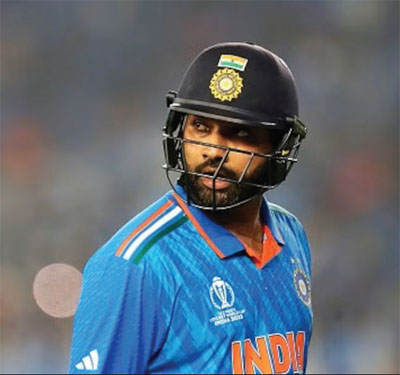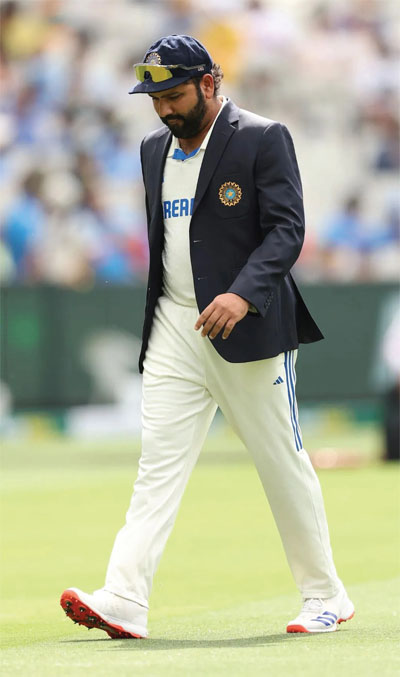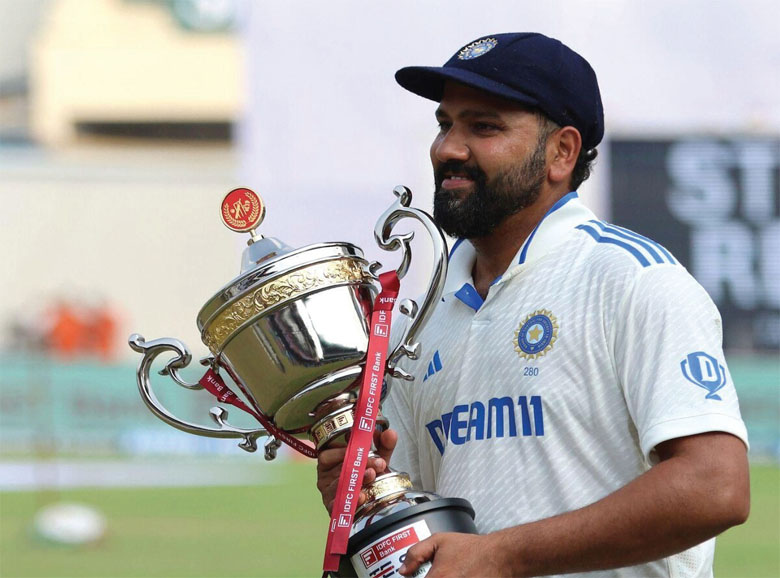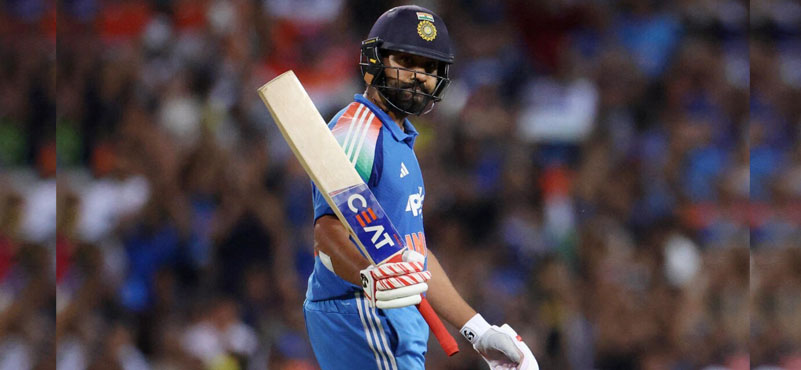In a cricket world that thrives on noise, swagger, and endless hot takes, Rohit Sharma remains a study in quiet control. At 38, when many careers wind down or fade into nostalgia, he continues to hold India’s top order and captaincy with an authority that feels less like dominance and more like stewardship. In the last few innings, though, when he let the country down, as also his vast fan following, there was clamour that he should consider stepping down. What he did instead, was to focus on physical fitness first, shedding a dozen kilos, setting himself to being again both fit and lean. Having already opted out of the five-day fixtures, as well as T20 format, being left with just the ODI format, a language in between the two formats left, he focussed again on what he had re-invented in his playing style – the lift powered by an aggressive bent of mind.
 He has clearly left it to himself to decide, after this string of three ODIs in Australia, winning both the Man of the Match and the Player of the Series, when he will take this final call. It is also a good time, when his career options are in his own hands, he can bid that final good bye. In some quarters, given his studied manner and grace, he can be seen as the next Rahul Dravid, the anchor of future teams.
He has clearly left it to himself to decide, after this string of three ODIs in Australia, winning both the Man of the Match and the Player of the Series, when he will take this final call. It is also a good time, when his career options are in his own hands, he can bid that final good bye. In some quarters, given his studied manner and grace, he can be seen as the next Rahul Dravid, the anchor of future teams.
In the age of T20 hyper-speed and social media hysteria, Rohit’s batting and leadership are throwbacks to a rarer virtue — composure. It’s this quality that has made him not just a prolific opener, but a cultural counterpoint to the volatility surrounding Indian cricket today.
A Performance That Ages Like Experience, Not Statistics
Look at his last 35 international innings, spread across Tests, ODIs, and T20s — and a quiet pattern emerges. There are centuries that made headlines (121* against Australia in Sydney, 131 against Afghanistan in the 2023 World Cup, 119 versus England earlier this year), but the real story lies in his consistency of temperament. Rarely has Rohit looked flustered, even when runs have come hard. While Dhoni may have clinched the title of Mr. Cool, it remains inexplicable how Rohit was overlooked for that title, just as much, if not more befitting the man.
Since the 2023 World Cup, he has averaged around 47 across formats, with a strike rate hovering near 90 in ODIs — figures that may not dazzle by modern standards, but speak of maturity and context. He no longer plays to impress; he plays to endure. The days of 200-plus fireworks have given way to innings where every shot serves a purpose.
His game has evolved from flamboyance to functionality — from the audacious pull shots of 2013 to the calculated placements of 2025. When India’s top order crumbles, Rohit’s value becomes clearest. His ability to set rhythm, manage tempo, and make batting look unhurried amid chaos is his real genius. His physique matches his style and aura, dependable to the core, except in those unlucky moments, when he has erred, which too started happening a bit more, in recent knocks.
Captaincy: The Art of Understatement
 Rohit’s leadership has always stood apart from the high-voltage theatrics of his predecessor, Virat Kohli. Where Kohli led with passion and personality, Rohit leads with patience and planning. His gestures are minimal, his words measured, his trust in teammates visible. He gives bowlers space, backs youth, and carries senior pros with quiet dignity. No wonder then, his last summing up statements on his departure from Sydney, he talked about the need to foster talent, and provide mentorship to the young. What is more, he acknowledged the mentoring he and his generation received when they were growing up, from the then seniors in the team.
Rohit’s leadership has always stood apart from the high-voltage theatrics of his predecessor, Virat Kohli. Where Kohli led with passion and personality, Rohit leads with patience and planning. His gestures are minimal, his words measured, his trust in teammates visible. He gives bowlers space, backs youth, and carries senior pros with quiet dignity. No wonder then, his last summing up statements on his departure from Sydney, he talked about the need to foster talent, and provide mentorship to the young. What is more, he acknowledged the mentoring he and his generation received when they were growing up, from the then seniors in the team.
Under his captaincy, India reached the 2023 World Cup final, lifted the 2025 Champions Trophy, and rebuilt the team’s balance after multiple transitions. His brand of leadership has not been about dominance; it has been about direction. It doesn’t make headlines but builds stability — something Indian cricket desperately needed.
Has the same calmness sometimes drawn criticism? In a country addicted to visible aggression, more hyper expressions of aggression and unbridled passion – witness the antics of Siraj, for instance, restraint can be often and easily misread as lack of fire. But those who have watched Rohit up close — and especially those who’ve played under him — have better understood that his silence has carried the weight of belief in himself. He has been that kind of leader who has spoken through his decision-making, not decibels.
Batting in Phases: A Reflection of Time
Few modern players mirror their nation’s evolution as Rohit does. His early career symbolized the promise of a youthful, audacious India — talented but erratic. The middle phase, when he opened regularly and racked up double centuries, reflected the country’s cricketing confidence — bold, expressive, and proud. His present avatar, methodical and composed, mirrors a maturing India — still ambitious, but more aware of consequence.
In his technique, you see lessons that go beyond cricket. Rohit waits — not just for the ball, but for the moment. He understands that rhythm, like success, cannot be forced. His mastery over timing, both literal and metaphorical, is why his innings often look slower than they are. When others chase momentum, he creates it.

T20 Conundrum: Measured in Risk, Not Recklessness
If there’s one space where Rohit divides opinion, it’s in T20s. Critics argue he has become too cautious, more anchor than aggressor. Supporters counter that he reads situations, not scoreboards. Both are right in part. In the 2024 T20 World Cup, his 57 against England in the semifinal was a reminder of his class under pressure, even as India fell just short in the final.
But what stands out isn’t a single innings — it’s his clarity. He doesn’t chase trends. He knows his role, and he adapts formats on his own terms. That’s why his T20 record, while not monstrous, remains deeply influential. Young openers — from Shubman Gill to Yashasvi Jaiswal — emulate his balance more than his power.
The Weight of Being the Calm One
In a sport that celebrates passion, calmness can be misunderstood as complacency. Rohit faces that paradox constantly. But there’s a deeper truth at play: it’s his composure that allows others to be expressive. He creates space for teammates to shine — a quality that rarely gets statistical recognition but defines great captains.
Compare him with global contemporaries: Babar Azam’s technique, Kane Williamson’s poise, or Ben Stokes’ intensity — Rohit stands as India’s equivalent of the thinking man’s cricketer. He plays like someone aware of time, aware that every innings now could be one of his last, and yet unwilling to compromise his craft for temporary applause.
Candidly Speaking: Flaws and Fortitude
Every legend carries shadows. For Rohit, they come in bursts of low scores when early dismissals dent momentum, or in knockout matches where India’s collective nerves have faltered. His strike rotation can tighten in Tests, and his field placements sometimes appear conservative. He’s not immune to criticism — nor does he pretend to be.
But what redeems him is awareness. Rohit doesn’t deflect blame; he absorbs it. After the 2023 World Cup final loss, he admitted he “could have done more.” In that moment of heartbreak, he stood not as captain or star, but as a man accountable to his team and country. In an age of self-promotion, that humility felt revolutionary.








